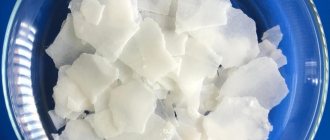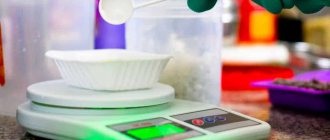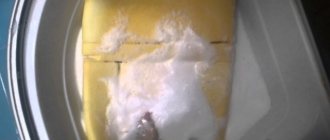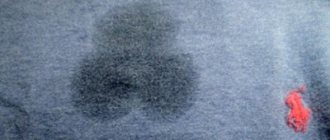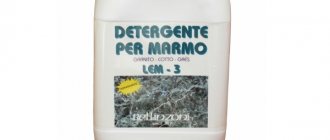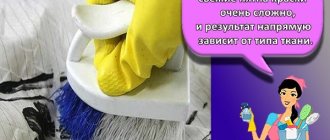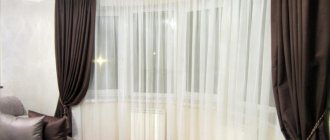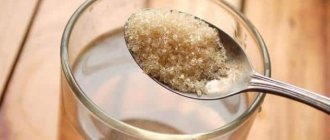In Soviet times, Belizna was the most common bleach with disinfectant properties, which was widely used for household needs of the population. After perestroika, many imported household chemicals appeared on store shelves and were forgotten for a while.
In recent years, this unique product has again attracted the attention of buyers. The range of applications for the antiseptic, disinfectant and bleaching properties of White has expanded significantly.
Release form
The commercial sale of Whiteness is carried out in 4 forms:
- in liquid form;
- in gel form;
- in powder form;
- in tablet form.
Depending on the form of release, the cost of the product varies. The difference in release forms is based on the target function and ease of use of the product.
Liquid aqueous solution
The liquid product is used to bleach natural fiber fabrics, wash floors, and clean white porcelain and earthenware. Sold in white or translucent plastic bottles or canisters with a screw cap of 1-5 liters.
Gel consistency
The gel variety is intended for washing plumbing fixtures and enamel bathtubs. A denser structure ensures the removal of rust and stubborn stains. Available in bottles with an extended dispenser, equipped with safety caps. The container volume is 0.5-1 l.
In powder form
The powder form is characterized by the absence of chloride compounds in the composition. It is suitable for use in washing machines as an additional product. Adding Whiteness to washing powder reduces its consumption, increasing the effectiveness of stain removal. Available in cardboard and plastic boxes. The powder variety is a cheap analogue of Vanish stain remover.
Tablet
The tablet form of the product is used for washing fabrics, sanitizing surfaces and disinfecting equipment. Available in 2 versions: with and without chlorine. Without chlorine it is used as a disinfectant, with chlorine it is used exclusively as a bleach. Sold in plastic tubes with a hinged or screw cap.
How to use Belizna for whitening
Since Belizna bleaches are produced in different concentrations, before use, carefully read the instructions for use. The correct dosage used will depend on this.
Important : only linen and cotton fabrics can be bleached with a chlorine-containing product.
Handwash
When using a regular product:
- pour 5 liters of warm (not higher than 30 degrees) water into a plastic or enamel container;
- dilute a glass of bleach (250 ml) in it;
- load the laundry so that it is completely covered with water;
- cover the container with cellophane and leave to soak for 30–40 minutes;
- rinse the laundry in two or three waters;
- wash things with the addition of regular powder in any convenient way.
Use tongs to remove laundry from the solution.
Using a concentrated gel, the same manipulations are carried out, only a smaller dosage is taken: for 5 liters of water you will need 30–40 ml of concentrate.
When using powdered whiteness, use the following proportions:
- to remove difficult stains, dissolve 1 tbsp. a spoonful of the product in 100 ml of water;
- Apply the resulting paste to the stain, leave for 5–10 minutes;
- wash the product in the usual way.
For soaking, dissolve 2 tbsp. spoons of bleach in 4 liters of water, immerse the laundry in the solution (for no more than 6 hours), wash as usual.
Machine washable
Sodium hypochlorite, contained in liquid varieties of white, has high corrosive properties. Therefore, the products cannot be used for machine washing. Washing machines use powdered bleach with a high content of active oxygen:
- add 2 tbsp. spoons of the substance to the main powder;
- set the double rinse mode;
- start the washing program.
In terms of its properties, powdered bleach is similar to another popular domestic stain remover - Persol, but costs 1.5 times less and is not inferior in effectiveness to another substance - peroxide.
Advantages and disadvantages
The popularity of Whiteness is ensured by the following advantages:
- low cost;
- high efficiency for local removal of contaminants;
- economical consumption;
- variety of commercial forms;
- wide range of uses;
- Possibility of use in cold water;
- Possibility of application to surfaces with a spray gun;
- preservation of properties after freezing.
The disadvantages of the product include:
- lack of measuring containers in the set;
- rapid consumption of non-concentrated products;
- clogging and leaking lids;
- impossibility of using colored fabrics, wool products and artificial fibers for washing;
- presence of a strong chlorine odor;
- aggressive effect on the skin of the hands and mucous membranes.
Pharmacodynamics and pharmacokinetics
Sodium Hypochlorite is one of the strongest antibacterial agents. Hypochlorite ion exhibits high activity against many known microorganisms, and acts in fairly low concentrations. The highest activity occurs at neutral pH. The particles formed during the decomposition of the substance oxidize the biopolymers in the structure of harmful agents and destroy the molecules of almost all organic substances. substrates. The product is active against gram-negative bacteria, Escherichia coli, serration, Pseudomonas aeruginosa, gram-positive bacteria, pathogenic fungi, protozoa, and viruses. However, the medicine does not act on the causative agents of cryptosporidiosis and giardiasis . The product does not have teratogenic, carcinogenic or mutagenic properties.
Application
The composition of Whiteness allows it to be widely used both in households, in medical institutions, and in industrial production. The product acts as a bactericidal agent, bleach, solution for disinfection and surface treatment.
At home
The wide range of possibilities for using Whiteness at home knows no bounds. It is used for cleaning and disinfecting surfaces, bleaching and decorating things, treating household items, and cleaning pet habitats. In addition, Whiteness helps in the fight against mold and is necessary for routine disinfection.
For the purpose of disinfection
Using chlorine bleach allows for thorough wet cleaning. Frequently used objects and surfaces are subject to treatment. The whiteness should be diluted 2 times and thoroughly irrigated with kitchen appliances, walls and floors, leaving for 2-3 hours. After time, items should be rinsed with plenty of water.
For whitening things
Whitening things is one of the main uses of Whiteness. It can only be used with cotton or linen fabrics in light shades. Use with colored or synthetic materials leads to fabric damage and discoloration.
The frequency of using White for bleaching things should be as little as possible, since constant use causes destruction of the fabric structure.
To maintain white color
Soaking the laundry in a White solution before the main wash helps preserve the snow-white color of products. It is necessary to dilute the product in the proportion of 1 tablespoon per 5 liters of water. The product should be soaked in the resulting solution for 20 minutes. Afterwards, rinse thoroughly and wash with your usual powder to neutralize the bleach odor.
Simple and effective ways to whiten linen and clothes
It is possible to bleach in a washing machine. For this purpose, there should not be a manufacturer’s ban on the use of chlorine-containing products. You cannot set the maximum temperature to avoid damage to equipment and neutralize the effect of Whiteness.
To remove gray and yellow stains
You need to dilute 2 tablespoons of Whiteness in 10 liters of warm water. Place contaminated items in water and leave for 1 hour. Afterwards, rinse the items thoroughly or put them in the washing machine.
When treating dense fabrics, the concentrated product should be poured onto the contaminated area and rinsed with water after a few minutes. Prolonged use of the concentrate leads to discoloration of the material.
Plumbing cleaning
Cleaning of plumbing equipment is carried out using the gel form of Whiteness. It is necessary to distribute the gel generously over the contaminated surface and leave for 30 minutes. When cleaning the toilet, first remove as much water as possible and pour the product down the drain. It is recommended to treat complex stains with a cloth or brush. After cleansing, Whiteness should be rinsed off with plenty of water.
To combat fungus and mold
Treatment against mold and fungi is carried out with a working solution of Whiteness diluted in equal proportions. It should be poured into a spray bottle and the necessary surfaces should be treated.
Floors and walls must first be fanned with a dry cloth to mechanically remove dirt and surface contaminants. After complete drying, the Whitening treatment should be repeated.
In case of extensive damage, a concentrated product is used.
To remove blockages in pipes
Cleaning and disinfection of sewage drains is carried out with a concentrated product. It is necessary to pour 1 liter of White into the clogged drain and close it with a stopper, leaving it for 9-12 hours. After incubation, flush the pipes with a large volume of cool water.
For clothing design (creating drawings on clothes)
The non-standard use of Whiteness for clothing design is called “tai dai”. Using bleach allows you to get patterns on your clothes. This way you can dye an old T-shirt, jeans or other items of clothing made from natural materials.
The uniqueness of the patterns is achieved by a special technique of twisting things and securing them in a folded state.
For the technique, a solution of Whiteness diluted twice is used. To obtain a soft effect, it can be poured into a spray bottle. After dyeing is completed, the clothes must be washed to neutralize the effect of the bleach.
If there are animals in the house
Keeping pets is associated with increased pollution. Trays, cages and enclosures need regular treatment with disinfectants to prevent the spread of pathogenic microflora and parasites. The use of Whiteness reduces the microbial load and eliminates unpleasant odors.
It is necessary to remove all animals during disinfection and start after the treated areas have completely dried.
For cleaning trays
As risk factors for the spread of zoonotic diseases, pet litter boxes require systematic disinfection. Whiteness should be diluted in water in a ratio of 1:10 and the trays should be treated with the working solution.
If your pet went to the toilet in a place not intended for this purpose, the contamination should be treated with Whiteness diluted 20 times.
For cleaning cages and enclosures
Cages and enclosures should be disinfected twice a year as follows:
- dilute 200 ml of the product in 5 liters of water and fill a spray bottle with the resulting solution;
- generously irrigate the entire surface of the cages, corners and floors of the enclosures with the working solution;
- leave the disinfectant for 2 hours;
- Rinse treated areas generously with water or a steam generator.
For cleaning the aquarium
The vital activity of aquatic inhabitants leads to the proliferation of microflora. To neutralize it on decorative items, you need to dilute 1 liter of White in 10 liters of warm water. Decorative elements should be immersed in the prepared solution for 2-3 hours. Afterwards, you need to rinse the items thoroughly, especially paying attention to porous surfaces. A solution of White may remain in small pores and, when transferred to an aquarium, will cause harm to its inhabitants.
In industry
In industrial enterprises, Whiteness is used as a bleach and oxidizer for chemical processes. It is necessary for bleaching fabrics and woody materials. The product is used for disinfection on an industrial scale and for sanitary and hygienic treatment.
Whiteness acts as a drinking water purifier in centralized water supply systems and wastewater disinfection.
Bactericidal properties have found application in food production. Bleach is used to treat food production equipment and remove organic residues from them.
In medicine
The antiseptic properties of Whiteness have gained wide popularity in medicine. Antifungal and bactericidal action allows the product to be used for local treatments. The hypochlorite contained in the composition is active against gram-positive and gram-negative pathogenic bacteria.
For intracavitary or external use, a 0.06% solution is used. In surgery it is used for washing and draining postoperative wounds. In otorhinolaryngology - for irrigating the throat and instilling into the external auditory canal. In dermatology - as a lotion for infectious skin processes. In dentistry it is used as an irrigation antiseptic.
In agriculture and on the site
At a summer cottage, it is necessary to disinfect greenhouse structures once a year. In conditions of elevated temperature and humidity, pathogenic bacteria multiply successfully. Treating the greenhouse in the fall reduces the risk of infection of the future crop.
First you need to remove all plant remains: roots, above-ground parts, garter material. Designs and rinse with a solution of Whiteness, diluted 1:20. Afterwards rinse with running water. To avoid damage to polycarbonate coatings, it is recommended to use soft fabrics and sponges.
Whiteness of tulle: folk remedies for whitening
To flush the well, you need to dilute 500 ml of White in a bucket of water and distribute the working solution along the walls. After filling with water, the disinfectant should be added at the rate of 1 liter per ring and left for 2 days. Over time, the contents must be pumped out several times until the chlorine odor is eliminated. It is prohibited to use water until cleaning is completed.
Whiteness: composition and characteristics
Whiteness is a clear solution with an unpleasant odor. In stores you can find the product in the form of a gel, but it is not so popular. A substance with similar properties and composition was first created in 1792 in Paris; a domestic mixture was released a little later. It is necessary to study the technical specifications of bleach for proper use.
Composition of the cleaning product Whiteness
The main components are sodium hypochlorite (it contains up to 95% active chlorine) and water. Whiteness - description and characteristics of substances in the composition:
- sodium hydroxide (or caustic soda);
- surface active substances that give bleach soapy qualities;
- fragrances, dyes and flavors (included in the Whiteness gel).
The product has two characteristics at once - whitening and cleansing. For a long time it was used not only to disinfect surfaces, but also to purify water. Whiteness is written under the chemical formula NaOCl.
What is bleach made from? Whiteness, technical characteristics
It is usually transparent and has a yellowish or greenish tint. Allow for slight sediment in the liquid. The light transmittance must be at least 70%. The mass concentration of active chlorine ranges from 70 to 85 gd/m3, but during storage it can be reduced to 35 gd/m3. For this reason, it is recommended to double the volume of solution when using it. Whitening ability on cotton, linen and other natural fabrics - from 80%.
Answers to frequently asked questions
There are many questions related to the use of Whiteness at home. Answers to the most common ones are collected and structured below.
Can it be used in the washing machine?
The use of White for machine wash is acceptable unless otherwise specified by the manufacturer. Machines designed for chlorine bleach have a separate compartment for adding the product. The maximum temperature should not be set. Heating water above 35℃ leads to the disintegration of active substances and a decrease in effectiveness. In addition, there is a chlorine-free form of Whiteness that is machine washable. There are no temperature restrictions when using it.
Can laminate flooring be washed?
It is unacceptable to use Whiteness to wash laminate flooring. Even a weakly concentrated solution harms the appearance and changes the color of the coating. Do not use aggressive acidic or alkaline agents to clean laminate flooring. As a last resort, a weak vinegar solution can be used.
Is it possible to wash linoleum?
Chlorine bleaches react aggressively with the top coating of linoleum. The use of White for washing linoleum leads to clouding of the protective layer, thinning and accelerating the formation of contamination of the coating. In addition, the pungent odor of the product is absorbed and remains on the surface for a long time. It is permissible to use a weak solution with a subtle chlorine odor. However, this method should be used only in extreme cases.
Can an acrylic bathtub be washed?
The acrylic coating of the bathtub cannot be cleaned or disinfected with White. It is prohibited to use any chlorine-containing products. Their contact leads to the destruction of acrylic and loss of shine. Also dangerous is the ingress of gasoline or acetone. To clean acrylic bathtubs, you should use special products with a gentle composition.
Is it possible to wash dishes?
Washing dishes with Whiteness is justified in case of quarantine. Soaking in a disinfectant for 1.5 hours destroys pathogenic microflora. In addition, Whiteness is used to add shine to glass products and restore the snow-white color of plates or mugs. An indispensable product for cleaning enamel products. For example, a pan can be soaked in a diluted solution for 1.5 hours. After which the dishes should be rinsed thoroughly.
Can wash be added to the pool?
Whiteness acts as a water disinfectant in the pool. The water must be heated to 32℃ and the product must be added at the rate of 75 ml per 1 cubic meter of water. Whiteness will not have the desired effect if the pH of the water is shifted to the acidic side. Chlorine-containing bleaches are most effective in an alkaline environment.
Is it possible to bleach white sneakers and sneakers?
To clean the soles of sneakers or sneakers, use a concentrated solution of Whiteness. The solution should only come into contact with the sole. The shoes should be kept in this condition for 2-3 hours, after which the rubber should be washed with running water. If the product gets on the textile part, it will damage the material and cause deformation.
Can tulle be used when washing?
Soaking in a Whiteness solution helps give tulle a snow-white appearance. Add 2 tablespoons of salt and 20 ml of White to a container of water. The tulle should be completely immersed in water for 1 hour and then rinsed. Fabric conditioner will help get rid of the chlorine smell.
Is it possible to lighten your hair?
Using White to lighten hair is unacceptable. The aggressive composition destroys the protein structure of the hair, leading to thinning and loss. The effect is especially harmful for colored or bleached hair. In addition, the chlorine contained in the composition dries out the hair, making it porous and dull.
Is it possible to boil Whiteness?
Boiling a concentrated product leads to the destruction of active substances and the release of chlorine. Prolonged exposure to heat neutralizes the cleaning properties of White. However, the combination of boiling with the addition of Whiteness is one of the most effective ways to bleach cotton and linen fabrics. However, the duration of boiling should not exceed 15 minutes, because the combination of high temperature and whiteness damages the structure of fabric fibers.
Is it possible to remove white stains on black?
It is possible to restore the dark color of an item after exposure to Whiteness if the stain is no more than 3 days old. A fresh stain can be restored by treating it with a solution of sodium thiosulfate, diluted in a ratio of 1 teaspoon per glass of water. For old stains, only the use of special dyes is suitable. At home, you can mask the stain with a marker or pencil. After dyeing, you need to put damp gauze on the back of the clothing and iron the area.
What to do if there are yellow spots from whiteness on the white?
Remaining yellow stains from Whiteness can be removed with hydrogen peroxide. Soak a cotton pad in peroxide and apply it to the stain. Afterwards, wash the item with washing powder. This method helps to get rid of fresh stains. For old yellow spots, aspirin is used. It is necessary to crush 2 tablets and mix them with water to obtain a homogeneous mass. Apply the resulting mixture to the stain and leave under pressure for 2-3 hours. After which the item must be washed with powder. Ammonia is used to remove stains from natural fabrics. You need to dilute 1 teaspoon in a glass of water and treat the item with the solution. After 30 minutes, it must be washed by hand using soap.
Harm of sodium hydroxide
The substance belongs to the second hazard class
Due to the ability of hydroxide to corrode organic compounds, the use of caustic must be carried out in compliance with all safety precautions. If alkali gets on the mucous membranes and skin, it causes severe burns, and interaction with the eyes leads to atrophy of the optic nerve
To neutralize the hydroxide on the skin, use a weak solution of vinegar and a large amount of running water.
Sewer cleaning
Sewer pipes tend to become clogged: grease, soap scum, and organic residues settle on their inner surface. All this is compressed, reducing the lumen of the pipe, the water does not drain well, and an unpleasant odor appears from the drain hole. The reasons can be both technical and operational:
- improper slope of the sewer system;
- roughness, burrs on the inner surface of pipes;
- many rough joints;
- the absence of a grate on the drain hole of the sink or bathtub, and as a result, organic contaminants - hair, paper, pieces of food - enter the drain;
- frequent draining of fatty food debris without subsequent flushing of pipes with hot water;
- lack of preventive measures to prevent the occurrence of deposits.
Before work, it is advisable to open hot water for a few minutes so that the sewer system warms up, and the pollution is better treated with alkali. There are several methods for cleaning sewers from greasy and organic contaminants using caustic soda:
- 1. Caustic solution in the amount of 2-3 tablespoons is poured into the hole, poured with a glass of boiling water, left for 2 hours, then washed with plenty of hot water. The granules must be poured strictly into the hole, because prolonged contact with the surface of the bathtub or sink can damage it. This method is used when the blockage is close to the drain hole.
- 2. If the system is thoroughly clogged over several meters, then use a large amount of solution, which is made at the rate of 3 kg of caustic soda per 7 liters of water. After thoroughly stirring it until the soda is completely dissolved, immediately pour it into the hole. After 2-3 hours, wash with water.
- 3. When the contamination is multi-layered, then to enhance the reaction, caustic alkali is used together with vinegar. To do this, pour 125 g of vinegar into the drain hole and add the same amount of caustic soda. The substances react and a lot of foam is formed, so the hole is tightly closed. After 2 hours, pour in boiling water.
A sodium hydroxide solution is used as a prophylactic agent once every 3 months to flush pipes from accumulated particles of grease and organic contaminants.
Alkalis are crystalline bases that are highly soluble in water. They are soapy to the touch and are strong catalysts for attacking a variety of materials, including porcelain or glass. Therefore, storing them in vessels that consist of these materials is strictly prohibited. Most often, plastic containers are used for this.
Caustic soda or caustic soda, scientific name is sodium hydroxide. A crystalline substance of light yellow or completely white color, commercially produced in the form of granules. Excellently dissolves various fats and has a strong cleaning effect. Cleans oil stains from various products, cleans sewer pipes from fatty build-ups.
You can find the best restaurants on Smolenskaya by visiting the website gayanes.ru. Only there there are excellent restaurants with the best cuisine and reasonable prices.
Slaked lime or scientifically called calcium hydroxide. It is most often used in the construction industry for whitewashing and plastering walls and ceilings.
Ammonia or ammonia solution is a liquid with a sharp, irritating, unpleasant odor that negatively affects the mucous membranes of the eyes and nose. In everyday life it is used as a 25 percent solution. With its help you can wash woolen products and remove stains that are of organic origin: resins, fats, milk. Recently, it has been widely used in window cleaning products. Since ammonia has excellent cleaning properties, it does not leave streaks on the surface of the glass. Also, a weak solution of ammonia is used to clean and add shine to gold and silver products; for this, the solution needs to be heated, and then the jewelry should be lowered there for a while. Ammonia is capable of forming compounds with metals that dissolve in water.
Approximate consumption table
Depending on the purpose of use, the consumption of Whiteness varies. Less concentrated solutions are intended for delicate effects. At the same time, more concentrated solutions are used to have an aggressive effect on pathogenic microflora.
How to bleach a white blouse at home: pay attention to the fabric
| Purpose | Consumption rate |
| Fabric bleaching | 50 g per 10 l |
| Removing stains | 50 g per 10 l |
| Washing dishes | 100 g per 1 l |
| Removing Tough Stains | 100 g per 1 l |
| Washing plumbing | 100 g per 1 l |
| Surface disinfection | 100 g per 1 l |
| Disinfection of dishes | 150 g per 1 l |
| Disinfection of garbage containers | 150 g per 1 l |
Drugs containing (Analogs)
Level 4 ATC code matches:
Naftalan oil
Suporon
Naftaderm
Vinylin
Hydrogen peroxide
Potassium permangantsovka
Iodoform
Pantocide
Diamond green
Ectericide
Salicylic-zinc paste
Elekasol
Salicylic-Zinc ointment
Formalin
Formagel
Aseptolin
Xeroform
Vitaon
Olazol
Formidron
The product is an active component of the drugs Amukin , Unisept . It is added to the composition of disinfectant solutions.
When not recommended for use
Frequent use of Whiteness is not recommended. Chlorine gas released when using the product has a negative effect on the respiratory system. In addition, chlorine-containing agents have an aggressive effect on any materials, leading to a change in their appearance and subsequent destruction.
It is not recommended to use Whiteness in the presence of children and pets. Due to their short stature, they are more susceptible to toxic fumes.
It is also not recommended to use a product that has expired or was stored in violation of safety regulations.
White-bleach
Note that the components in gel-white are more complex; it also contains the following:
- perfume fragrances;
- additional thickeners;
- surface-acting detergents, as well as rust-dissolving agents.
Whiteness gel is stored for about a year, but the container should always be well closed, since otherwise the gel will lose its main properties.
For more information about the product white bleach, what it is, how to use white, what is the composition of white, its characteristics, etc., watch the video that we offer for viewing.
Did this article help you?
Storing sodium hypochlorite
Sodium hypochlorite should be stored in unheated areas with good ventilation. Neighborhood storage with organic substances, flammable substances and acids is unacceptable. If it comes into contact with dry rags, the material will spontaneously ignite. Contact and ingress of heavy metal salts must be excluded.
It is recommended to store the product at a temperature of 15-35℃. At temperatures above 35℃, active substances decompose with the release of active chlorine. A drop in temperature to -7℃ leads to crystallization of the product. Complete hardening occurs at -25℃.
It is necessary to choose a place inaccessible to children. After opening the bottle, the product remains effective for 6 months. As the expiration date approaches, the active components erode, causing the product's effectiveness to decrease.
Sodium and potassium salts
Sodium and potassium form salts with all acids. Sodium and potassium salts are very similar in chemical properties. A characteristic feature of these salts is their good solubility in water, so there are no available high-quality reactions to the ions of these elements. The presence of even an insignificant amount of sodium or potassium ions in a compound is determined by introducing this compound into a colorless flame: in the case of sodium, the flame turns yellow, and in the case of potassium, pink-violet. Sodium and potassium form medium, acid, double and complex salts. Most sodium and potassium salts are thermally stable and decompose only at very high temperatures. With moderate heating, only salts of halogenated oxoacids, nitrates and some other compounds decompose:
Acid salts are less stable; when heated, they all decompose:
These elements do not form basic salts
.
Of the salts, sodium chloride is the most important - NaCl
- salt.
It is a necessary component of food, a preservative, and a raw material for the chemical industry. From it sodium hydroxide, baking soda (NaHCO3), soda (Na2CO3) and many other sodium compounds are obtained. Many sodium salts form crystalline hydrates. Na2S2O3?Н2О
– sodium thiosulfate, corresponding to thiosulfuric acid
Н2S2O3,
is used in photography to fix developed papers.
Na2SO4?10H2O
- sodium sulfate decahydrate, Glauber's salt, is used in the sulfate method for producing soda and in glass production.
Na2CO3?10H2O
- sodium carbonate or soda ash is used in the glass, soap, pulp and paper, textile, oil, chemical industries, as well as in everyday life.
NaNO3
- sodium nitrate, sodium or Chilean nitrate - is used as a mineral fertilizer.
Potassium salts are necessary mineral fertilizers. Na2SiO3
– sodium silicate – used in glass production.
Potassium salts are released from solution mainly without water of crystallization. K2CO3 -
potassium carbonate or
potash
- is used in the production of soap, in the production of refractory glass, in photography.
KNO3 -
potassium carbonate or potassium nitrate - is used in the manufacture of black powder.
KCl
– potassium chloride – is used as a fertilizer.
Many potassium salts are found in nature: KCl? MgCl? 6H2O – carnallite;
КCl?NaCl – sylvinite .
K
salts are contained in alum.
Safety instructions
Before you start using the product, you need to protect yourself from the harmful effects of aggressive compounds. It is necessary to wear rubber gloves and a gauze or medical bandage. There should be a flow of fresh air into the room. When working with Belizna, children and pets should be removed from the premises.
When processing vertical surfaces, you need to protect your eyes with glasses from possible splashes. To avoid damage to clothing, a protective gown or unnecessary clothing should be used. It is necessary to strictly follow the instructions for use when preparing working solutions.
To soak laundry, cover the basin with plastic wrap. When disinfecting plumbing fixtures, you need to plug the drain holes or cover the toilet lid.
T-shirt designs
This is one of the most non-standard approaches. On boring plain T-shirts, you can create an interesting pattern using bleach. We draw any image on an A4 sheet. Next, lay down a sheet of parchment paper (it usually has a yellowish tint and is translucent, so the design will show through). Turn the parchment paper over to the other side and seal the design with strips of double-sided tape. Cut out the image along the contour so that only the silhouette remains. Removes the protective layer of double-sided tape. We put perforated cardboard inside the T-shirt. We paste the ornament onto the T-shirt, smoothing the picture or pressing it with our hands. When working with a design, it is better to cover the T-shirt with paper or other material so as not to accidentally damage the fabric. Pour 20 grams of bleach and spray it over the surface of the drawing (do not pour it, you need a sprayer). Apply a napkin to absorb excess liquid. Next, you need to dry it well, you can iron the design with an iron, then spray it and dry it again. Watch how the color changes. It is advisable to apply this idea to dark or colored T-shirts.
Harm to human health and first aid
Failure to comply with safety precautions and manufacturer's recommendations leads to injury. The product can cause harm through inhalation of vapors, accidental ingestion and contact with the skin and mucous membranes.
First aid consists of thoroughly sanitizing the damaged area in case of contact with the skin or removing the victim to fresh air. Then you should call an ambulance.
In case of vapor poisoning
There are 4 stages of poisoning by White vapors.
The mild stage manifests itself in the form of a sore throat, burning and tearing of the eyes. There are no consequences of such poisoning, and the symptoms go away on their own within 24 hours. To alleviate the condition, provide fresh air, loosen clothing that restricts breathing, and give plenty of fluids.
The average degree is characterized by the addition of a severe dry cough, a feeling of tightness in the chest area. May be accompanied by the development of minor pulmonary edema. First aid measures are the same as for the mild stage, but an immediate call to an ambulance is required. Before doctors arrive, it is necessary to monitor the victim’s pulse and breathing rhythm.
The severe stage includes a short-term cessation of breathing followed by recovery. Restored breathing is accompanied by difficulties and disturbances and requires drug treatment. Before doctors arrive, it is necessary to feel the pulse and, if breathing stops again, carry out resuscitation measures.
In case of contact with mucous membranes or skin
Contact of white on the skin is accompanied by the development of a chemical burn. Regardless of the length of stay on the skin or the concentration of the product used, the skin should be rinsed thoroughly with running water. It is prohibited to treat the damaged area with iodine or brilliant green solution. After washing, you can soften the skin with Bepanten and consult a dermatologist for treatment.
Any bleach that gets into your eyes should be washed thoroughly with running water. To relieve inflammation and speed up the recovery of the mucous membrane, Albucid should be instilled. Afterwards, you need to contact an ophthalmologist to diagnose the severity of the lesion and prescribe treatment.
Water purification
When it is not possible to boil (on a hike, outside the city), bleach is suitable for purifying drinking water. It kills 90% of bacteria, as it contains chlorine, which is harmful to them. We collect 15 units using an insulin syringe (100 units). This is conventionally 0.15 ml, or 0.2 ml if the water is river or of poor quality. Add bleach to two liters of water, shake or stir, wait 2 hours. Residual chlorine is removed by filtration.
What can be replaced
You can replace Whiteness with a product containing the same active ingredient, sodium hypochlorite. These include:
- Amukin;
- Belen;
- Hypostabil;
- Domestos and Domestos Universal;
- Clorox;
- Chistin;
- Sanfor;
- Comet WC and Comet gel;
- Neoseptal chlorine;
- Rimazon-chlor;
- Chlorosept B.
The listed drugs have similar disinfectant and antiseptic effects, but have additional components in their composition.
Whiteness is the most common and inexpensive disinfectant. Its range of applications includes the food industry, medicine and household needs. The substances included in the composition give the product an antibacterial and antifungal effect. However, the aggressive composition imposes restrictions on use. Compliance with safety precautions and the manufacturer's instructions will allow you to keep your home clean and keep things looking snow-white without much expense.
Whiteness in gel form
Currently, production of another form of this common product has been launched, which is in great demand among buyers. Whiteness gel has a composition and characteristics that differ from traditional ones. It includes additional components:
- Organic substance Trilon-B. Active solvent for rust and oxides.
- Nonionic surfactant. Emulsifier and thickener for liquid media.
- Flavored flavors (lemon, apple, etc.).
Physical properties
Hypochlorites are found mainly in the form of aqueous solutions, although some of them can be isolated in solid form. Thus, anhydrous sodium hypochlorite is known, which is an unstable colorless crystalline substance. Of the crystalline hydrates, the most stable form is NaClO×5H2O. This compound appears as white or pale green rhombic crystals that diffuse in air. When sodium hypochlorite pentahydrate is heated to a temperature of 24.4°C, it melts. Crystalline hydrate NaClO×2.5H2O melts at a temperature of 57.5°C. The monohydrate is extremely unstable and decomposes above 60°C; at higher temperatures, decomposition occurs explosively.
Table 2. Densities and freezing temperatures of aqueous solutions of sodium hypochlorite.
| Concentration, % | 1 | 2 | 4 | 6 | 8 | 10 | 14 |
| Density, g/ml (18 °C) | 1,0053 | 1,0121 | 1025,8 | 1,0397 | 1,0538 | 1,0681 | 1,0977 |
| Concentration, % | 18 | 22 | 26 | 30 | 34 | 38 | 40 |
| Density, g/ml (18 °C) | 1,1288 | 1,1614 | 1,1953 | 1,2307 | 1,2680 | 1,3085 | 1,3285 |
| Concentration, % | 2 | 4 | 6 | 8 | 10 | 12 | 15,6 |
| tzam, °С | – 2,2 | – 4,4 | – 7,5 | – 10,0 | – 13,9 | – 19,4 | –29,7 |
Unlike potassium hypochlorite, which is known only in solutions, calcium hypochlorite can be isolated in the form of colorless crystals that are stable in a dry atmosphere without carbon dioxide. Calcium hypochlorite can be isolated from aqueous solutions in the form of crystalline hydrates Ca(ClO)2×2H2O, Ca(ClO)2×3H2O, Ca(ClO)2×4H2O.
The acid-base equilibrium between hypochlorous acid and hypochlorite ion is described by a reversible reaction with an equilibrium constant Ka = 2.63 × 10–8 at 20°C.
HClO = H+ + ClO–.
Using the equilibrium constant Ka, it is possible to calculate the molar fractional distribution of hypochlorous acid and hypochlorite ions depending on pH (Fig. 1).
Data indicate that when hypochlorite solutions are acidified, the proportion of unstable hypochlorous acid increases. At pH < 7.58, the solution contains predominantly hypochlorous acid, and at pH > 7.58, predominantly hypochlorite ions exist.
Rice. 1. Mole fraction distribution of hypochlorous acid and hypochlorite ions depending on the acidity of the medium.
